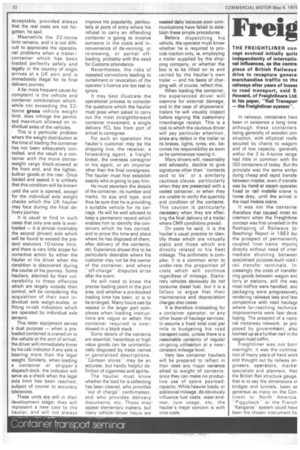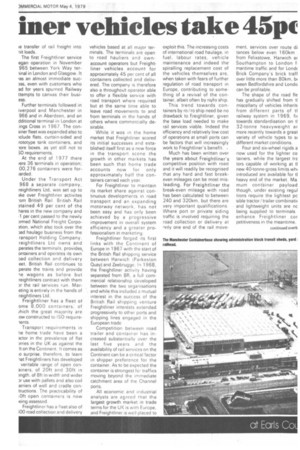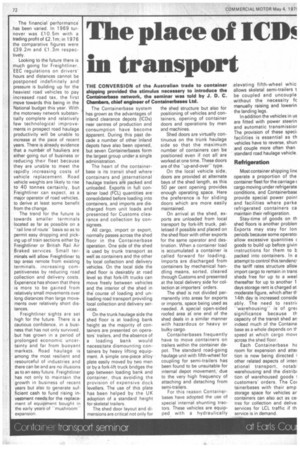Freig finer vehicles take 45pc
Page 72

Page 73

Page 74

If you've noticed an error in this article please click here to report it so we can fix it.
THE FREIGHTLINER concept evolved initially quite independently of international influences, as the centre piece of British Railways' drive to recapture general merchandise traffic to the railways after years of lossem to road transport, said S Howard, of Freightliners Ltd, in his paper, "Rail Transpori — the Freightliner system".
In railways, containers havE been in existence a long time although these containers being generally of wooden con struction, with elliptical roofs
secured by chains to wagon: and of low capacity, generally within the 2 to 4-tonne range had little in common with thE ISO containers of today. But thE principle was the same embo. dying cheap and rapid transfel .between modes, even if transfei was by hand or steam operatec fixed or rail mobile crane tc horse dray, until the arrival a the road mobile crane.
It was not the containei therefore that caused most ex citement when the Freightlinel concept was first unveiled in thE Reshaping of Railways (oi Beeching) Report in 1963 bis the prospect of permanently coupled "liner trains' movinc directly without need of inter. mediate shunting betweer specialised purpose-built road / rail transfer terminals. In creasingly the costs of transfer. ring goods between wagon anc lorry at stations, still the way most traffics were handled, anc packaging Were progressively rendering railways less and lesF. competitive with road haulagE where far-reaching technica improvements were fast deve• loping. The prospect of a natio. nal motorway network, as pro. posed by government, alsc loomed up as a further nail in thE wagon-load coffin.
Freightliner was not borr overnight; it was the culmina• tion of many years of hard work and thought out by railway en. gineers, operators, market specialists and planners. Hac the British Rail structure gauge, that is to say the dimensions ol bridges and tunnels, been at generous as many on the Con. tinent or North America, "Piggybackor the French -Kangaroo" system could havE been the chosen instrument for
ie transfer of rail freight into lit loads.
The first Freightliner service egan operation in November 965 between York Way ter
linal in London and Glasgow. It ,as an almost immediate suc
ss, even with customers who ad for years spurned Railway ttempts to canvas their busiess.
Further terminals followed in iverpool and Manchester in 966 and in Aberdeen, and an dditional terminal in London at ings Cross in 1967. The con finer fleet was expanded also to Iclude flats. curtain-sided and rototype tank containers, and lore boxes. as yet still not to 30 requirements.
At the end of 1977 there ,ere 36 terminals in operation; 00,276 containers were fortarded Under the Transport Act 968 a separate company, reightliners Ltd, was set up to
Ike over Freightliner activites .om British RaiL British Rail
atained 49 per cent of the 'nares in the new company and ,1 per cent passed to the newly )rmed National Freight Corpo )tion, which also took over the )ad haulage business from the ransport Holding Company. reightliners Ltd owns and perates the terminals, provides, ontainers and operates its own Dad collection and delivery eet. British Rail continues to perate the trains and provide le wagons as before but reightliners contract with them )r the rail services run. Mareting is entirely in the hands of reightliners Ltd.
Freightliner has a fleet of ome 8,000 containers: of /filch the great majority are ow constructed to ISO require Transport requirements in le home trade have been a actor in the prevalence of flat yries in the UK as against the It on the Continent. It comes as o surprise, therefore, to learn iat Freightliners has developed veritable range of open con3iners, of 20ft and 30ft in mgth, of i8ft in width and wider Y use with pallets and also coil arriers of well and cradle contructions. The practicability of .Oft open containers is now ieing assessed.
Freightliner has a fleet also of i00 road collection and delivery vehicles based at all major terminals. The terminals are open to road hauliers and own account operators but Freightliner vehicles account for approximately 45 per cent of all containers collected and deliv ered. The company is therefore also a throughout operator able to offer a flexible service with road transport where required but at the same time able to leave road movements to and from terminals in the hands of others where commercially desirable.
While it was in the home market that Freightliner scored its initial successes and established itself first as a new force in the transport scene the growth in other markets has been such that home trade accounts now for only approximately half the containers carried each year.
For Freightliner to maintain its market share against continuous developments in road transport and an expanding motorway network, has not been easy and has only been achieved by a progressive improvement in overall system efficiency and a greater professionalism in marketing.
Freightliner forged its first links with the Continent of Europe in 1967 with the start of the British Rail shipping service between Harwich (Parkeston Quay) and Zeebrugge. In 1968, the Freightliner activity having separated from BR, a full commercial relationship developed between the two organisations and while this included a mutual interest in the success of the British Rail shipping venture Freightliner interests extended progressively to other ports and shipping lines engaged in the European trade_ Competition between road trailer and container has increased substantially over the last five years and the availability of rail services on the Continent can be a critical factor in shipper preference for the container. As to be expected the container is strongest for traffics moving beyond the immediate catchment area of the Channel ports.
All economic and industrial analysts are agreed that the largest growth market in trade terms for the UK is with Europe, and Freightliner is well placed to exploit this. The increasing costs of international road haulage, in fuel, labour rates, vehicle maintenance and indeed the' spiralling replacement cost of the vehicles themselves are, when taken with fears of further regulation of road transport in Europe, contributing to something of a revival of the container, albeit often by ro/ro ship.
This trend towards containers by ro/ro ship need be no drawback to Freightliner, given the base load needed to make rail services viable. Indeed the efficiency and relatively low cost of operations at small ports can be factors that will increasingly work to Freightliner's benefit. .
Much has been written over the years about Freightliner's competitive position with road and it will readily be recognised that any hard and fast breakeven mileages can be most misleading. For Freightliner the break-even mileage with road has been calculated to between 240 and 320km, but there are very important qualifications. Where port or private siding traffic is involved requiring the road collection or delivery at only one end of the rail move
ment, services over route di tances below even 160km from Felixstowe, Harwich at Southampton to London f. maritime traffic and for Londt Brick Company's brick trafi over little more than 80km, hi ween Bedfordshire and Londo can be profitable.
The shape of the road fle has gradually shifted from tl miscellany of vehicles inherit, from different parts of tl railway system in 1969, fil towards standardisation on ti 32-tonne heavyweight ar more recently towards a great variety of vehicle types to si different market conditions.
Four and six-wheel rig ids a now used for the lighter co tainers, while the largest tre tors capable of working at tl new 40-tonne-gross limits whr introduced are available for tl heavy end of the market. Ma mum combiner payload though, under existing regul tions require the lightest pc sible tractor/trailer combinatii and lightweight units are nc being supplied to terminals enhance Freightliner cor petitiveness in the meantime. The financial performance' has been varied. In 1969 turnover was £10.5m with a trading profit of £2.1 m; in 1976 the comparative figures were £39.2m and £1.3m respectively.
Looking to the future there is much going for Freightliner. EEC regulations on drivers' hours and distances cannot be postponed indefinitely and pressure is building up for the heaviest road vehicles to pay increased road tax, the first move towards this being in the National budget this year. With the motorway network substantially complete and relatively few technological improvements in prospect road haulage productivity will be unable to increase at the pace of recent years. There is already evidence that a number of hauliers are either going out of business or reducing their fleet because they are unable to meet the rapidly increasing costs of vehicle replacement. Road vehicle weights are likely to rise to 40 tonnes certainly, but Freightliner can expect, as a major operator of road vehicles, to derive at least some benefit from the change.
The trend for the future is towards smaller terminals located as far as possible on a "rail line of route'' basis so as to permit easy dropping and picking up of train sections either by Freightliner or British Rail Air Braked services. Small terminals will allow Freightliner to tap areas remote from existing terminals, increasing competitiveness by reducing road collection and delivery costs. Experience has shown that there is more to be gained from relatively small movements over long distances than large movements over relatively short distances.
Freightliner sights are set high for the future. There is a cautious confidence, in a business that has not only survived, but has grown in a period of prolonged economic uncertainty and far from buoyant markets. Road haulage is among the most resilient and resourceful of industries and there can be and are no illusions as to an easy future. Freightliner has not only to maintain the growth in business of recent years but also to generate sufficient cash to fund rising investment needs for the replacement of equipment bought in the early years of "mushroom" expansion.
























































































































